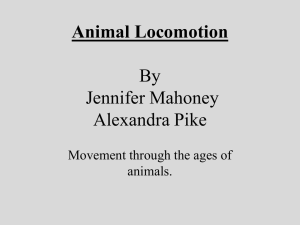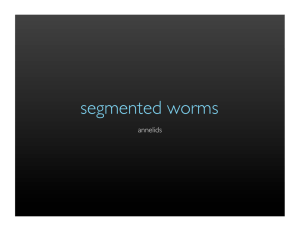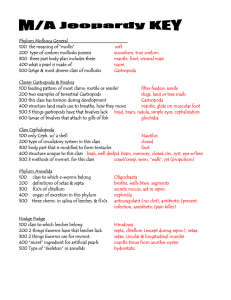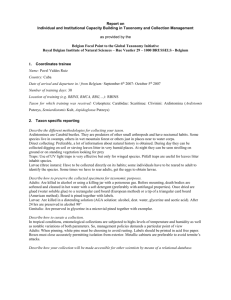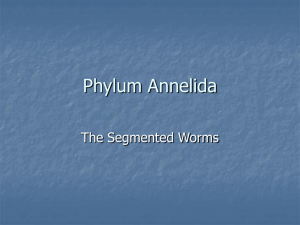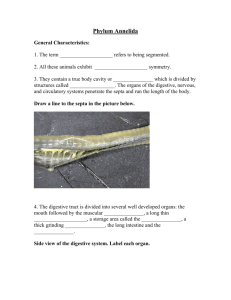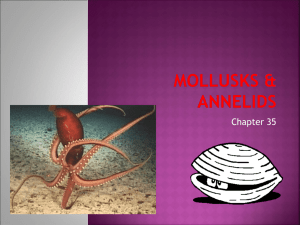Discovery of Novocriniidae (Copepoda, Harpacticoida) from cold-water
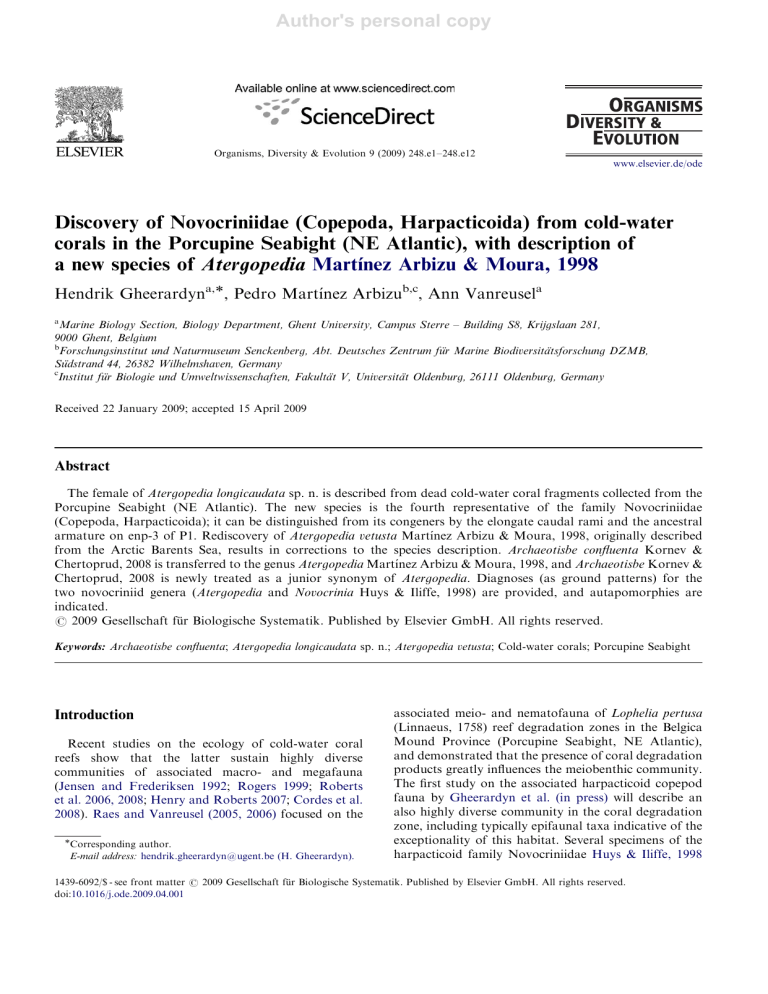
Author's personal copy
ARTICLE IN PRESS
Organisms, Diversity & Evolution 9 (2009) 248.e1–248.e12
www.elsevier.de/ode
Discovery of Novocriniidae (Copepoda, Harpacticoida) from cold-water corals in the Porcupine Seabight (NE Atlantic), with description of a new species of Atergopedia Mart ı´ nez Arbizu & Moura, 1998
Hendrik Gheerardyn
a,
, Pedro Mart ı´ nez Arbizu
b,c
, Ann Vanreusel
a a
Marine Biology Section, Biology Department, Ghent University, Campus Sterre – Building S8, Krijgslaan 281,
9000 Ghent, Belgium b
Forschungsinstitut und Naturmuseum Senckenberg, Abt. Deutsches Zentrum fu¨r Marine Biodiversita¨tsforschung DZMB, c
Su¨dstrand 44, 26382 Wilhelmshaven, Germany
Institut fu¨r Biologie und Umweltwissenschaften, Fakulta¨t V, Universita¨t Oldenburg, 26111 Oldenburg, Germany
Received 22 January 2009; accepted 15 April 2009
Abstract
The female of Atergopedia longicaudata sp. n. is described from dead cold-water coral fragments collected from the
Porcupine Seabight (NE Atlantic). The new species is the fourth representative of the family Novocriniidae
(Copepoda, Harpacticoida); it can be distinguished from its congeners by the elongate caudal rami and the ancestral armature on enp-3 of P1. Rediscovery of Atergopedia vetusta Mart ı´ nez Arbizu & Moura, 1998, originally described from the Arctic Barents Sea, results in corrections to the species description.
Archaeotisbe confluenta Kornev &
Chertoprud, 2008 is transferred to the genus Atergopedia Mart ı´ nez Arbizu & Moura, 1998, and Archaeotisbe Kornev &
Chertoprud, 2008 is newly treated as a junior synonym of Atergopedia . Diagnoses (as ground patterns) for the two novocriniid genera ( Atergopedia and Novocrinia Huys & Iliffe, 1998) are provided, and autapomorphies are indicated.
r 2009 Gesellschaft f u¨ r Biologische Systematik. Published by Elsevier GmbH. All rights reserved.
Keywords: Archaeotisbe confluenta ; Atergopedia longicaudata sp. n.; Atergopedia vetusta ; Cold-water corals; Porcupine Seabight
Introduction
Recent studies on the ecology of cold-water coral reefs show that the latter sustain highly diverse communities of associated macro- and megafauna
( Jensen and Frederiksen 1992 ; Rogers 1999 ; Roberts et al. 2006, 2008 ; Henry and Roberts 2007 ; Cordes et al.
2008 ).
Raes and Vanreusel (2005, 2006) focused on the
Corresponding author.
E-mail address: hendrik.gheerardyn@ugent.be (H. Gheerardyn).
associated meio- and nematofauna of Lophelia pertusa
(Linnaeus, 1758) reef degradation zones in the Belgica
Mound Province (Porcupine Seabight, NE Atlantic), and demonstrated that the presence of coral degradation products greatly influences the meiobenthic community.
The first study on the associated harpacticoid copepod fauna by Gheerardyn et al. (in press) will describe an also highly diverse community in the coral degradation zone, including typically epifaunal taxa indicative of the exceptionality of this habitat. Several specimens of the harpacticoid family Novocriniidae Huys & Iliffe, 1998
1439-6092/$ - see front matter r 2009 Gesellschaft f u¨ r Biologische Systematik. Published by Elsevier GmbH. All rights reserved.
doi: 10.1016/j.ode.2009.04.001
Author's personal copy
ARTICLE IN PRESS
H. Gheerardyn et al. / Organisms, Diversity & Evolution 9 (2009) 248.e1–248.e12
248.e2
were collected from samples of dead coral fragments, and found to belong to Atergopedia vetusta Mart ı´ nez
Arbizu & Moura, 1998 and a new representative of the genus Atergopedia Mart ı´ nez Arbizu & Moura, 1998 , respectively.
Originally, A. vetusta was described from muddy sediments covered by a mat of sponge spicules on the continental slope of the Arctic Barents Sea, north-west off Franz-Josef-Land ( Mart ı´ nez Arbizu and Moura
1998 ). To accommodate their new species, its authors proposed a new family name, Atergopediidae, but this became a junior synonym as Huys and Iliffe (1998) had established the name Novocriniidae earlier in the same year. The latter authors described Novocrinia trifida
Huys & Iliffe, 1998 from two anchialine caves on the
Belize barrier reef, and considered their species as semiplanktonic in habit. Recently, Kornev and Chertoprud
(2008) added a third genus and species, Archaeotisbe confluenta Kornev & Chertoprud, 2008 , from shallow, shelly bottoms in the White Sea.
With only three known species, the Novocriniidae is a very small family; the present description of a fourth species contributes to better knowledge of this rare taxon.
In addition, we transfer Archaeotisbe confluenta to
Atergopedia and consider the genus name Archaeotisbe as a junior synonym of Atergopedia . Previously,
Novocriniidae was believed to be endemic to anchialine caves ( Huys and Iliffe 1998 ), but the discoveries of Atergopedia in the Arctic Ocean, the shallow
White Sea, and now from cold-water corals in the
Porcupine Seabight suggest a much wider distribution of the family.
Atergopedia longicaudata sp. n. is the fourth harpacticoid species described from a coldwater coral ecosystem, next to Halophytophilus lopheliae Gheerardyn et al., 2008 (Ectinosomatidae),
Parameiropsis antennafortis Corgosinho & Gheerardyn, in press (Harpacticoida incertae sedis), and a new species of Ancorabolina George, 2006 (Ancorabolidae)
( Gheerardyn et al. 2008 ; Corgosinho and Gheerardyn
2009 ; Gheerardyn and George in press ).
All material was fixed in 4% buffered formaldehyde. In the laboratory, each coral sample was rinsed thoroughly over 1 mm and 32 m m sieves to collect macro- and meiofauna, respectively. Meiofauna from the sediment was extracted by density-gradient centrifugation, using
Ludox HS40 (specific density 1.18) as a flotation medium ( Heip et al. 1985 ; Vincx 1996 ). Harpacticoid copepods were sorted and counted using a Wild M5 binocular microscope. Dissected parts of the specimens were mounted in glycerine, and preparations sealed with insulating varnish. Drawings were made with the aid of a drawing tube on a Leica DMR microscope equipped with differential interference contrast (DIC), at 1000x magnification. Whole specimens were stored in 75% ethanol.
The new specimens have been deposited in the
Invertebrate Collections of the Royal Belgian Institute of Natural Sciences (KBIN), Brussels, labelled with collection numbers beginning with the letters ‘‘COP’’.
Additional material mentioned below is kept at the
Forschungsinstitut und Naturmuseum Senckenberg,
Frankfurt, Germany (SMF), and at the Shirshov
Institute of Oceanology, Russian Academy of Sciences,
Moscow, Russia (SIO), respectively.
The following abbreviations are used in the descriptive text: A1 ¼ antennule; A2 ¼ antenna; aes ¼ aesthetasc; benp ¼ baseoendopod; enp ¼ endopod; enp-1 (2, 3) ¼ proximal (middle, distal) segment of endopod; exp ¼ exopod; exp-1 (2, 3) ¼ proximal (middle, distal) segment of exopod; P1–P6 ¼ first to sixth thoracopod. Scale bars in the figures are given in m m.
Taxonomic section
Family Novocriniidae Huys & Iliffe, 1998
Atergopediidae Mart ı´ nez Arbizu & Moura, 1998
Genus Atergopedia Mart ı´ nez Arbizu & Moura, 1998
Archaeotisbe Kornev & Chertoprud, 2008, syn. n .
Material and methods
The new material described in this paper was collected during expedition RV Belgica 01/12 in the
Belgica Mound Province of the Porcupine Seabight
(NE Atlantic Ocean), in May 2001. Samples were taken with a box corer in the coral degradation zone of
Lophelia pertusa reefs, at depths between 880 and 972 m.
In the box corers, the surface of the sediment was partly or entirely covered with several dead fragments of the cold-water coral L. pertusa . After collecting the coral fragments, meiofauna of underlying sediment was sampled with three sediment cores (surface area 10 cm
2
).
Diagnosis (ground pattern, apomorphies in boldface)
Novocriniidae. First pedigerous somite incompletely fused to cephalosome and lacking tergite . Posterolateral corners of cephalic shield and P2–P4-bearing somites rounded. Pseudoperculum absent. Rostrum triangular, with simple tip. Enp-1 of A2 without abexopodal seta .
Enp-2 of A2 with multiplication of lateral, distinct setae in female (without setoid tuft), and additionally with a lateral and a subapical setoid tuft in male. Mandibular endopod one-segmented. Maxillipedal syncoxa with seta. Enp-1 of P1 without inner seta . Baseoendopod
Author's personal copy
ARTICLE IN PRESS
H. Gheerardyn et al. / Organisms, Diversity & Evolution 9 (2009) 248.e1–248.e12
and exopod of P5 fused in female . Endopodal lobe of male P5 with 2 spines.
Atergopedia longicaudata sp. n.
( Figs. 1–8 ; 9 A, B)
Etymology
The species epithet is derived from the Latin words longus (meaning long) and cauda (tail), in reference to the long caudal rami. It is to be treated as an adjective for the purposes of nomenclature.
248.e3
Type material
Holotype female, dissected on 14 slides (COP 7696a–n);
North-East Atlantic Ocean, Porcupine Seabight, box corer Bbc01-1203 (Belgica Cruise 01/12), 51
1
25.3120
0 N,
11
1
46.0226
0 W, depth 969 m, sample of dead coral fragment, 7 May 2001, leg. G. De Smet.
Paratypes. One female preserved in 75% alcohol
(COP 7697), data as for holotype. One female dissected on 14 slides (COP 7698a–n) and one female preserved in 75% alcohol (COP 7699); data as for holotype, except box corer Bbc01-1205, 51
1
25.9290
0 N, 11
1
46.2717
0 W, depth 880 m.
Fig. 1.
Atergopedia longicaudata sp. n., holotype female. (A) Habitus, dorsal. (B) Caudal setae IV and V, dorsal. (C) Habitus, lateral.
248.e4
Author's personal copy
ARTICLE IN PRESS
H. Gheerardyn et al. / Organisms, Diversity & Evolution 9 (2009) 248.e1–248.e12
Fig. 2.
Atergopedia longicaudata sp. n., holotype female. (A) Antenna, 5 setae on enp-2 omitted; see subfigure B. (B) 5 setae on enp-2 of antenna.
Diagnosis
The female of Atergopedia longicaudata sp. n. can be differentiated from its congeners by the combination of elongate caudal rami (two times as long as wide), loss of abexopodal seta on basis of antenna, loss of seta on basis of maxilliped, ancestral armature on enp-3 of P1
(with two inner setae), loss of outer spine on enp-3 of P2, and characteristic numbers of setal versus spiniform elements on female P5.
Description of female holotype
All illustrations made from holotype, except Fig. 3 A
(showing A1 of paratype COP 7698), as most antennular setae of holotype were broken after dissection.
Habitus ( Fig. 1 A, C) fusiform, tapering posteriorly, with slight demarcation between prosome and urosome.
Body length (measured from anterior margin of rostrum to posterior margin of telson) 346 m m. Length of caudal rami 32 m m. First pedigerous somite incompletely fused to cephalosome ( Figs. 1 A, B; 9 B) and practically free, but lacking a tergite and concealed beneath an extension of the cephalic shield and a broad, striated frill. Cephalic shield with sensilla and pores as figured; increasing in width posteriorly ( Fig. 1 A: slightly wider than natural condition due to mounting). Rostrum broad triangular with simple tip, fused to cephalic shield, with 2 sensilla
( Fig. 8 C, D). Hyaline frills striated and smooth on prosomites and first urosomite; striated and finely serrated on second half of genital double-somite and following two urosomites ( Fig. 8 A). Genital doublesomite and following two urosomites with continuous transverse row of spinules ventrally, laterally and dorsally near posterior margin. P5-bearing somite with lateral spinule row as figured ( Fig. 1 C). Telson with proximal rows of spinules laterally and ventrally, and with row of spinules along posterior margin ( Figs. 8 A, B;
9 A). Anal operculum weakly developed, with row of spinules along posterior margin ( Fig. 9 A). Caudal rami ( Figs. 8 A, B; 9 A) cylindrical and elongate, 2 times as long as wide, bearing 7 setae. Seta I minute, inserting at one fourth length of outer margin. Setae I, II and
VII bare; setae III, IV, V and VI pinnate. Setae IV and
V long, with distinct fracture planes. Seta VII triarticulate at base.
Author's personal copy
ARTICLE IN PRESS
H. Gheerardyn et al. / Organisms, Diversity & Evolution 9 (2009) 248.e1–248.e12
248.e5
Fig. 3.
Atergopedia longicaudata sp. n., (A) paratype female COP 7698, (B, C) holotype female. (A) Antennule. (B) Mandible.
(C) Maxilliped.
Antennule ( Fig. 3 A) 9-segmented, slender, with aesthetascs on fourth and last segments. First segment with spinules along inner margin. Armature formula:
1/8/5/2+ae/1/2/2/2/7+ae.
Antenna ( Fig. 2 A, B) with short coxa. Basis without seta, completely separate from endopod. Exp 4-segmented, distal segment indistinctly subdivided; segments 1–3 each with 1 long pinnate seta; segment 4 with
2 long pinnate setae and 1 minute smooth seta. Enp
2-segmented; enp-1 without seta; enp-2 with several rows of spinules, medially with 8 unipinnate setae and
1 geniculate seta on inner and anterior margin, distally with 3 geniculate and 3 slender setae.
Mandible ( Fig. 3 B). Coxa elongate, gnathobase with 1 pinnate seta and several distal teeth. Basis with 1 inner seta; exp 4-segmented, with setal formula 1/1/1/2 and a
1-segmented enp bearing 1 inner and 5 distal setae.
Maxillule ( Fig. 4 A–D). Praecoxa subdistally with
4 setae on anterior protrusion, apically with 5 setae; anteriorly with 2 surface setae. Coxal endite cylindrical, with 5 setae. Basis with two endites bearing 4 setae each.
Exopod 1-segmented, small and cylindrical, outwardly directed, bearing two long, apical setae. Endopod
1-segmented, bearing 6 distal setae.
Maxilla ( Fig. 4 E, F). Syncoxa with 1 endite bearing
2 setae. Basis drawn out into strong, pinnate claw; accessory armature consisting of 1 pinnate and 1 smooth seta. Endopod 2-segmented, with 2 geniculate setae on proximal segment and 3 geniculate setae as well as
1 slender seta on distal segment.
248.e6
Author's personal copy
ARTICLE IN PRESS
H. Gheerardyn et al. / Organisms, Diversity & Evolution 9 (2009) 248.e1–248.e12
Fig. 4.
Atergopedia longicaudata sp. n., (A–E) holotype female, (F) paratype female COP 7698. (A) Maxillule; arrow indicates anterior protrusion of praecoxa. (B) Proximal endite of basis of maxillule. (C) Distal endite of basis of maxillule. (D) Endopod of maxillule. (E) Maxilla (slightly tilted), syncoxa proximally damaged; arrows indicate setae on enp-1. (F) Maxilla, endopod omitted.
Maxilliped ( Fig. 3 C). Subchelate, well developed.
Syncoxa with 1 small inner seta at distal corner, with spinular pattern as figured. Basis without seta, with several rows of spinules along palmar and outer margin.
Endopod 2-segmented; first endopodal segment with
1 short, inner seta, and distal margin produced into a strong, pinnate claw; second endopodal segment with
1 slender seta proximally inserted on base of segment, and 2 distal, geniculate setae.
Swimming legs P1–P4 ( Figs. 5 A–C; 6 A–C; 7 B, C) with well developed praecoxae, coxae, bases, and
3-segmented rami; with pattern of pores and long and minute spinules as figured. Intercoxal sclerites rectangular; of P1 with, of P2–P4 without distal spinules.
Bases forming triangular process between insertion sites of rami; with outer pinnate spine (P1–P2) or pinnate seta
(P3–P4); inner distal corner with inner pinnate spine
(P1). Endopods reaching to middle of respective exp-3.
P1 ( Fig. 5 A, B) more slender than following swimming legs. Exp-2 about 1.5 times as long as wide. Distal outer corners of exp-2, enp-1 and enp-2 of P1 forming spinous processes. Posterior surface of exopodal segments, enp-2 and enp-3 with short spinule rows. Enp-3 with distinctly stepped inner margin; bearing 2 inner setae, 2 distal setae and 1 slender outer spine. Exp-3 with
6 elements.
P2–P4 ( Figs. 5 C; 6 A–C; 7 B, C). Outer exopodal spines more strongly developed than in P1. Posterior
Author's personal copy
ARTICLE IN PRESS
H. Gheerardyn et al. / Organisms, Diversity & Evolution 9 (2009) 248.e1–248.e12
248.e7
Fig. 5.
Atergopedia longicaudata sp. n., holotype female. (A) P1, armature of exp-3 omitted. (B) Exp-3 of P1. (C) P2.
surface of exopodal segments with short spinule rows, of enp-2 and enp-3 with few, single spinules. Outer distal corners of exopodal segments and inner and outer distal corners of endopodal segments forming spinous processes. Swimming-leg setal formulae as in Table 1 .
P5 ( Fig. 7 A). Benp and exp fused, forming one wide plate; with 3 pores on anterior surface; with outer basal seta arising from short setophore. Endopodal lobe with
4 strong spines, exopodal lobe with 3 strong spines and
2 setae. Small spinous process present between endopodal and exopodal lobe. Small intercoxal sclerite present.
Genital double-somite ( Figs. 1 A, C; 8 A) wider than long; with subcuticular ridge ventrally and laterally, representing original segmentation. Genital field located in proximal half of genital double-somite. Copulatory pore located medially. Sixth legs represented by two plates medially fused, armed with 3 setae each.
Variation
Body length (measured from anterior margin of rostrum to posterior margin of telson) 306–346 m m
(average 334 m m; n ¼ 4).
Male
Unknown.
Atergopedia vetusta Mart ı´ nez Arbizu &
Moura, 1998
( Fig. 9 C–E)
Material examined
Holotype female, dissected on 17 slides (SMF coll.
nos. 1997.20/1–1997.20/17); Arctic Ocean, continental slope of Barents Sea, north-west off Franz-Josef-Land,
248.e8
Author's personal copy
ARTICLE IN PRESS
H. Gheerardyn et al. / Organisms, Diversity & Evolution 9 (2009) 248.e1–248.e12
Fig. 6.
Atergopedia longicaudata sp. n., holotype female. (A) P3, armature of exp-3 partly omitted. (B) P4, armature of exp-3 omitted. (C) Praecoxa of P3.
82
1
7.42
0 N, 42
1
32.35
0 E, depth 534 m, box corer sample from muddy sediments covered by mat of sponge spicules about 2 cm thick, 28 August 1993 ( Mart ı´ nez
Arbizu and Moura 1998 ). Allotype male, dissected on
13 slides (SMF coll. nos. 1997.21/1–1997.21/13), data as for holotype.
Two females in 70% alcohol (COP 8650); North-East
Atlantic Ocean, Porcupine Seabight, box corer Bbc01-
1203 (Belgica Cruise 01/12), 51 1 25.3120
0 N, 11 1 46.0226
0 W, depth 969 m, sample of dead coral fragment, 7 May 2001, leg. G. De Smet. One male and one female in 70% alcohol
(COP 8651); as previous, except box corer Bbc01-1205,
51
1
25.9290
0 N, 11
1
46.2717
0 W, depth 880 m.
Corrections to species description
Female A1 ( Fig. 9 C) segment 7 bears 2 setae (rather than 1).
Proximal basal endite of maxillule ( Fig. 9 D) bears 4
(rather than 3) distal setae.
Basis of maxilla ( Fig. 9 E) bears 2 setae (rather than 1), which are proximally inserted.
Atergopedia confluenta
2008 ), comb. n.
( Kornev & Chertoprud,
Archaeotisbe confluenta Kornev & Chertoprud, 2008
Type material (not seen)
Holotype female, dissected on 4 slides (SIO coll.
nos.
Har28–Har31); White Sea, Maliy Eremey
Island (Rugoserskaya Gulf, Karelian Coast, Kandalaksha
Bay), 66
1
33 0 N, 33
1
07 0 E, depth 10 m, shelly bottoms ( Kornev and Chertoprud 2008 ). Allotype male,
Author's personal copy
ARTICLE IN PRESS
H. Gheerardyn et al. / Organisms, Diversity & Evolution 9 (2009) 248.e1–248.e12
248.e9
Fig. 7.
Atergopedia longicaudata sp. n., holotype female. (A) P5. (B) Exp-3 of P3. (C) Exp-3 of P4.
dissected on 1 slide (SIO coll. no. Har32); data as for holotype.
problems. Therefore, Archaeotisbe is treated as a junior synonym of Atergopedia here.
Remarks
Unaware of the publication by Mart ı´ nez Arbizu and
Moura (1998) , Kornev and Chertoprud (2008) proposed the new genus and species Archaeotisbe confluenta for a novocriniid collected from the White Sea. The drawings of A. confluenta show only minor differences with Atergopedia vetusta (limited numbers of fewer setae on male A1, female A1 and A2, respectively; one endite less on maxillar syncoxa; no seta on basis of maxilliped), which could possibly be due to observational errors.
The habitus seems wider and slightly compressed in
A. confluenta , more elongate in A. vetusta . We have doubts about the validity of A. confluenta , which might be synonymous with A. vetusta . However, since the type material was not available for study, we abstain from formal synonymisation.
However, the few, small differences noted above do not justify a separate genus Archaeotisbe ; instead,
A. confluenta fits within Atergopedia without any
Genus Novocrinia Huys & Iliffe, 1998
Diagnosis (ground pattern, apomorphies in boldface)
Novocriniidae. Cephalothorax incorporating first pedigerous somite. Posterolateral corners of cephalic shield and P2–P4-bearing somites produced into spinous processes. Pseudoperculum moderately developed and semicircular. Dorsal rear margins of caudal rami produced into backwardly directed spinous processes .
Caudal seta I absent . Rostrum with trifid tip . Anterior margin of first antennular segment produced into small spinous process. Modified spines present on proximal segments of antennule. Enp-1 of A2 with abexopodal seta. Enp-2 of A2 with lateral setoid tuft in female, and with additional, subapical setoid tuft in male. Mandibular endopod 2-segmented . Maxillipedal syncoxa without seta. Enp-1 of P1 with inner seta. Baseoendopod and exopod of P5 not fused. Endopodal lobe of male P5 with
4 spines .
248.e10
Author's personal copy
ARTICLE IN PRESS
H. Gheerardyn et al. / Organisms, Diversity & Evolution 9 (2009) 248.e1–248.e12
Fig. 8.
Atergopedia longicaudata sp. n., holotype female. (A) Urosome, ventral. (B) Telson and caudal ramus, lateral. (C) Rostrum, ventral. (D) Rostrum, dorsal.
Discussion
The main apomorphy of Novocriniidae is the presence of sexually dimorphic setoid tufts on the inner margin of the second endopodal segment of the antenna, the condition of which is not exactly the same in the two genera, Atergopedia and Novocrinia . Each setoid tuft consists of a dense cluster of filamentous structures; this condition is interpreted as a secondary multiplication of setal elements ( Huys and Iliffe 1998 ; Mart ı´ nez Arbizu and Moura 1998 ). In the female of Novocrinia trifida , the lateral armature of this antennary segment consists of two setae and a setoid tuft (conceivably representing the missing third setal element). The male additionally carries a subapical, second setoid tuft (which is regarded as a transformed distal setal element) ( Huys and Iliffe
1998 ). The situation is different in Atergopedia , where the female antennary enp-2 lacks a dense cluster of filamentous structures. However, the lateral armature shows a multiplication of distinct setae and consists of
1 geniculate seta and 6 or 8 slender setae in A. vetusta and A. longicaudata , respectively. The male antenna of
A. vetusta additionally bears a medial and a subapical setoid tuft. However, due to the high number of these seta-like structures, it could not be evaluated whether there are 1 apical and 1 medial seta less than in the female, which would be the homologues of these setoid tufts. The condition in the male of A. longicaudata remains to be seen, as only the female has been found.
Because both novocriniid genera were established almost simultaneously, the recognition of autapomorphies for each genus was impossible at the time. Although
Novocrinia and Atergopedia are still very small genera
(with one and three species, respectively), we consider the major diagnostic apomorphies of Atergopedia to be the following (plesiomorphic conditions in brackets): First pedigerous somite incompletely fused to cephalosome and lacking tergite (fused to cephalosome); baseoendopod and exopod of P5 fused in female (separate); loss of
Author's personal copy
ARTICLE IN PRESS
H. Gheerardyn et al. / Organisms, Diversity & Evolution 9 (2009) 248.e1–248.e12
248.e11
Fig. 9.
(A, B) Atergopedia longicaudata sp. n., holotype female; (C–E) A. vetusta Mart ı´ nez Arbizu & Moura, holotype female.
(A) Telson and caudal rami (setae IV and V of left caudal ramus broken), dorsal. (B) Habitus, lateral, showing first pedigerous somite incompletely fused to cephalosome. (C) Segments 6–8 of antennule. (D) Proximal basal endite of maxillule. (E) Maxilla, armature of syncoxal endites and endopod omitted.
P1
P2
P3
P4
Table 1.
Atergopedia longicaudata sp. n., swimming-leg setal formulae.
Leg Coxa Basis Exopod Endopod
0-0
0-0
0-0
0-0
I-I
I-0
1-0
1-0
I-0; I-1; III-2-1 0-0; 0-1; I-2-2
I-1; I-1; III-I+1-2 0-1; 0-2; 0-2-2
I-1; I-1; III-I+1-3 0-1; 0-2; I-2-3
I-1; I-1; III-I+1-3 0-1; 0-2; I-2-2 abexopodal seta on enp-1 of A2 (seta present); and loss of inner seta on enp-1 of P1 (seta present).
For the genus Novocrinia , the following characters are considered as the major apomorphies (plesiomorphic conditions in brackets): Anterior margin of first antennular segment produced into small spinous process (process absent); modified spines present on proximal segments of antennule (normal setae); 4 spines present on endopodal lobe of male P5 [considered as a secondary phenomenon;
Huys and Iliffe 1998 ] (fewer than 4 spines present).
Additionally, Seifried (2003) considered the 2-segmented condition of the mandibular endopod also as a secondary phenomenon and as apomorphic for Novocrinia .
Distribution
The rediscovery of Atergopedia vetusta from the continental slope of the Porcupine Seabight extends
Author's personal copy
ARTICLE IN PRESS
H. Gheerardyn et al. / Organisms, Diversity & Evolution 9 (2009) 248.e1–248.e12
248.e12
the distribution range of this species to a depth of 969 m and to a longitude of 51
1
25.3
0 N in the NE Atlantic
Ocean. The collection of Atergopedia from the shallow waters of the White Sea ( Kornev and Chertoprud 2008 ) also indicates a wide bathymetrical range for this genus.
Together with the present description of a new species from cold-water corals in the Belgica Mound Province, these findings further show that Novocriniidae is not an exclusively cavernicolous taxon. Nevertheless, with only four known species, the Novocriniidae still form a small and rare harpacticoid family.
Acknowledgements
The first author acknowledges a postdoctoral research grant from the Special Research Fund (Ghent University, BOF). The studied material was collected within the framework of the HERMES project (EC Sixth
Framework Research Programme under the priority
‘‘Sustainable Development, Global Change and Ecosystems’’), and the research project G.0199.03, ‘‘A Comparative Study of the Meio-Epifauna Associated with
Tropical and Cold-Water Coral Reefs’’, sponsored by the Fund for Scientific Research (FWO-Flanders,
Belgium). Two anonymous reviewers are kindly thanked for critically reading the manuscript and providing constructive remarks. The present study was supported by a small grant from the Taxonomy Clearing System
(MarBEF). This publication is contribution number
MPS-09019 of MarBEF.
References
Cordes, E.E., McGinley, M.P., Podowski, E.L., Becker, E.L.,
Lessard-Pilon, S., Viada, S.T., Fisher, C.R., 2008. Coral communities of the deep Gulf of Mexico. Deep-Sea Res. Pt.
I 55, 777–787.
Corgosinho, P.H., Gheerardyn, H., 2009. A new species of
Parameiropsis Becker, 1974 (Copepoda: Harpacticoida) from the Porcupine Seabight (NE Atlantic). Mar. Biodiv.
Gheerardyn, H., De Troch, M., Vincx, M., Vanreusel, A., in press. Harpacticoida (Crustacea: Copepoda) associated with cold-water coral substrates in the Porcupine Seabight
(NE Atlantic): species composition, diversity and reflections on the origin of the fauna. Sci. Mar.
Gheerardyn, H., George, K.H., in press. New representatives of the genus Ancorabolina George, 2006 (Harpacticoida,
Ancorabolidae) including remarks on ancorabolid phylogeny. Zool. J. Linn. Soc.
Gheerardyn, H., Seifried, S., Vanreusel, A., 2008. A new species of Halophytophilus Brian, 1919 (Copepoda:
Harpacticoida: Ectinosomatidae) from cold-water corals in the Porcupine Seabight (NE Atlantic). Zootaxa 1761,
1–16.
Heip, C., Vincx, M., Vranken, G., 1985. The ecology of marine nematodes. Annu. Rev. Oceanogr. Mar. Biol. 23, 399–489.
Henry, L.-A., Roberts, J.M., 2007. Biodiversity and ecological composition of macrobenthos on cold-water coral mounds and adjacent off-mound habitat in the bathyal Porcupine
Seabight, NE Atlantic. Deep-Sea Res. Pt. I 54, 654–672.
Huys, R., Iliffe, T.M., 1998. Novocriniidae, a new family of harpacticoid copepods from anchihaline caves in Belize.
Zool. Scr. 27, 1–15.
Jensen, A., Frederiksen, R., 1992. The fauna associated with the bank-forming deepwater coral Lophelia pertusa (Scleractinaria) on the Faroe shelf. Sarsia 77, 53–69.
Kornev, P.N., Chertoprud, E.S., 2008. Veslonogie Rakoobraznye Otryada Harpacticoida Belogo Morya: Morfologiya, Sistematika, Ekologiya. [Copepod Crustaceans of the
Order Harpacticoida of the White Sea: Morphology,
Systematics, Ecology]. Tovarishchestvo Nauchnikh Izdanii
KMK, Moscow. In Russian.
Mart ı´ nez Arbizu, P., Moura, G., 1998. Atergopediidae, a new family of harpacticoid copepods (Crustacea) from oligothrophic Arctic sediments. Zool. Beitr. 38, 189–210.
Raes, M., Vanreusel, A., 2005. The metazoan meiofauna associated with a coldwater coral degradation zone in the
Porcupine Seabight (NE Atlantic). In: Freiwald, A.,
Roberts, J.M. (Eds.), Cold-water Corals and Ecosystems.
Springer, Berlin, Heidelberg, pp. 821–847.
Raes, M., Vanreusel, A., 2006. Microhabitat type determines the composition of nematode communities associated with sediment-clogged cold-water coral framework in the
Porcupine Seabight (NE Atlantic). Deep-Sea Res. Pt. I
53, 1880–1894.
Roberts, J.M., Henry, L.-A., Long, D., Hartley, J.P.,
2008. Cold-water coral reef frameworks, megafaunal communities and evidence for coral carbonate mounds on the Hatton Bank, north east Atlantic. Facies 54,
297–316.
Roberts, J.M., Wheeler, A.J., Freiwald, A., 2006. Reefs of the deep: the biology and geology of cold-water coral ecosystems. Science 312, 543–547.
Rogers, A.D., 1999. The biology of Lophelia pertusa (Linnaeus
1785) and other deep-water reef-forming corals and impacts from human activities. Int. Rev. Hydrobiol. 84, 315–406.
Seifried, S., 2003. Phylogeny of Harpacticoida (Copepoda):
Revision of ‘‘Maxillipedasphalea’’ and Exanechentera.
Cuvillier Verlag, G o¨ ttingen.
Vincx, M., 1996. Meiofauna in marine and freshwater sediments. In: Hall, G.S. (Ed.), Methods for Examination of Organismal Diversity in Soils and Sediments. CAB
International, Wallingford, pp. 187–195.

